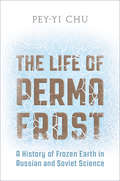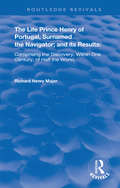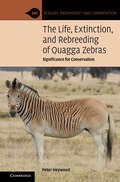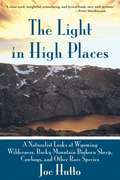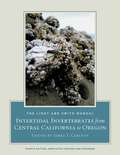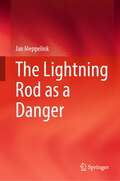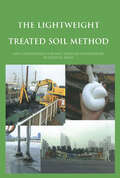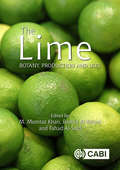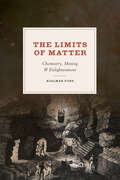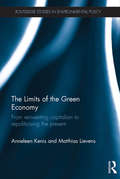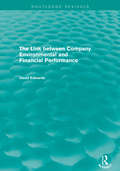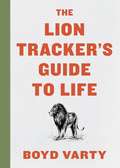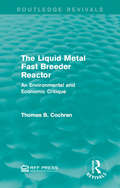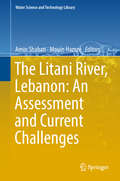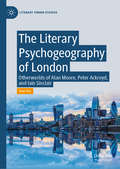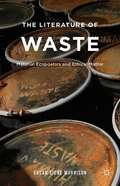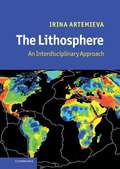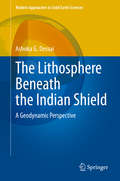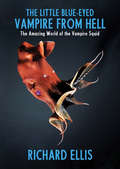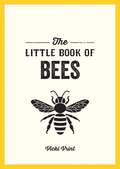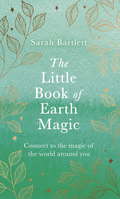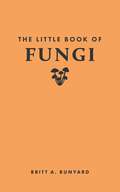- Table View
- List View
The Life of Permafrost: A History of Frozen Earth in Russian and Soviet Science
by Pey-Yi ChuIn the Anthropocene, the thawing of frozen earth due to global warming has drawn worldwide attention to permafrost. Contemporary scientists define permafrost as ground that maintains a negative temperature for at least two years. But where did this particular conception of permafrost originate, and what alternatives existed? The Life of Permafrost provides an intellectual history of permafrost, placing the phenomenon squarely in the political, social, and material context of Russian and Soviet science. Pey-Yi Chu shows that understandings of frozen earth were shaped by two key experiences in the Russian Empire and the Soviet Union. On one hand, the colonization and industrialization of Siberia nourished an engineering perspective on frozen earth that viewed the phenomenon as an aggregate physical structure: ground. On the other, a Russian and Soviet tradition of systems thinking encouraged approaching frozen earth as a process, condition, and space tied to planetary exchanges of energy and matter. Aided by the US militarization of the Arctic during the Cold War, the engineering view of frozen earth as an obstacle to construction became dominant. The Life of Permafrost tells the fascinating story of how permafrost came to acquire life as Russian and Soviet scientists studied, named, and defined it.
The Life of Prince Henry of Portugal: Surnamed the Nabigator and its Results (Routledge Revivals)
by Richard Henry MajorOriginally published in 1868, this book follows the life of Prince Henry, including chapters on the Siege of Tangier, the capture of Ceuta and the death of Prince Henry.
The Life, Extinction, and Rebreeding of Quagga Zebras: Significance for Conservation (Ecology, Biodiversity and Conservation)
by Peter HeywoodQuaggas were beautiful pony-sized zebras in southern Africa that had fewer stripes on their bodies and legs, and a browner body coloration than other zebras. Indigenous people hunted quaggas, portrayed them in rock art, and told stories about them. Settlers used quaggas to pull wagons and to protect livestock against predators. Taken to Europe, they were admired, exhibited, harnessed to carriages, illustrated by famous artists and written about by scientists. Excessive hunting led to quaggas' extinction in the 1880s but DNA from museum specimens showed rebreeding was feasible and now zebras resembling quaggas live in their former habitats. This rebreeding is compared with other de-extinction and rewilding ventures and its appropriateness discussed against the backdrop of conservation challenges—including those facing other zebras. In an Anthropocene of species extinction, climate change and habitat loss which organisms and habitats should be saved, and should attempts be made to restore extinct species?
The Light In High Places: A Naturalist Looks at Wyoming Wilderness--Rocky Mountain Bighorn Sheep, Cowboys, and Other Rare Species
by Joe HuttoNaturalist Joe Hutto's latest adventures in wildlife observation take him to Wyoming's Wind River Mountains. Hutto is living in a tent at 12,000 feet, where blizzards occur in July and where human wants become irrelevant and human needs can become a matter of life and death-to study the Rocky Mountain bighorn sheep. The population of these rare alpine sheep is in decline. The lambs are dying in unprecedented numbers. Hutto's job is to find out why. For months at a time, he follows the bighorn herds, meets mountain lions and bears, weathers injury and storms, and beautifully observes the incredible splendor of the Rocky Mountains. Hutto has a deep connection to Wyoming, having managed a large cattle ranch in his past. He weaves Wyoming's history of the cowboy, mountain ecology, and the lives of the bighorn sheep into a beautiful flowing narrative. Ultimately, he discovers that the lambs are dying of a form of nutritional muscular dystrophy due to selenium deficiency, which is caused by acid rain-a grim ecological disaster caused by human pollution. Here is a new twist on a cautionary tale, and a new voice, eloquently ex-pressing the urgency that we mend our ways.
The Light and Smith Manual: Intertidal Invertebrates from Central California to Oregon
by James T. CarltonThe Fourth Edition of The Light and Smith Manual continues a sixty-five-year tradition of providing to both students and professionals an indispensable, comprehensive, and authoritative guide to Pacific coast marine invertebrates of coastal waters, rocky shores, sandy beaches, tidal mud flats, salt marshes, and floats and docks. This classic and unparalleled reference has been newly expanded to include all common and many rare species from Point Conception, California, to the Columbia River, one of the most studied areas in the world for marine invertebrates. In addition, although focused on the central and northern California and Oregon coasts, this encyclopedic source is useful for anyone working in North American coastal ecosystems, from Alaska to Mexico. More than one hundred scholars have provided new keys, illustrations, and annotated species lists for over 3,500 species of intertidal and many shallow water marine organisms ranging from protozoans to sea squirts. This expanded volume covers sponges, sea anemones, hydroids, jellyfish, flatworms, polychaetes, amphipods, crabs, insects, snails, clams, chitons, and scores of other important groups. The Fourth Edition also features introductory chapters on marine habitats and biogeography, interstitial marine life, and intertidal parasites, as well as expanded treatments of common planktonic organisms likely to be encountered in near-to-shore shallow waters.
The Lightning Rod as a Danger
by Jan MeppelinkThis book investigates the physical effects of a lightning flash on a person near the down conductor of a lightning protection system. These effects are the touch voltage, the step voltage and the side flash. For this purpose, a full-scale simulation model of the human body with a resistance of 1000 ohms was first created. In the simulation model, the body can touch the down conductor or be placed close to it. Furthermore, the specific resistance of the earth is varied. Likewise, insulating layers such as asphalt can be incorporated into the simulation model. Also, special cases like water permeable layers or water layers on an asphalt layer can be calculated. In post-processing, all relevant values can be determined, such as the energy converted in the body, the charge, the current and the voltage applied to the body. A comparison with the permissible limit values then shows for the lightning protection classes whether there is danger or not and provides information on necessary measures. There is a risk for death and injury if the down conductor is touched. However, there is also a risk of a side flash if a person is standing next to a discharge. Site isolation with dry asphalt is effective, but there is a residual risk of surface discharges. In real situations with wet asphalt, water-permeable layers or asphalt with a water layer, however, there is a great risk of death or injury. Equipotential bonding with an earthing grid is a necessary but not sufficient solution with regard to the induced voltage at negative subsequent stroke. Therefore, the situation must always be examined on a case-by-case basis with regard to the safety requirements. The only effective measure to prevent injury and death due to touch voltage is an insulating down conductor in conjunction with equipotential bonding. The measures for reducing the touch voltage, such as site insulation and equipotential bonding, basically also apply to limiting the step voltage. A risk calculation according to IEC 62305-2 gives the mean time between two events of injury and death MG = 1/RA. The tolerable risk is: RA = 0,0001 or MT = 10.000 years, equivalent to one death in 10.000 years.
The Lightweight Treated Soil Method: New Geomaterials for Soft Ground Engineering in Coastal Areas
by Takashi Tsuchida Kazuhiko EgashiraThis is an in-depth practical examination of the newly developed Lightweight Treated Soil Method, based on the extensive research and experience of two leading recognized experts. Indispensable to geotechnical and construction engineers or to researchers and professionals interested in coastal engineering techniques, geotechnical engineering or geo
The Lime
by M. Mumtaz Khan Rashid Al-Yahyai Fahad Al-SaidThis book is a comprehensive and up-to-date resource covering the botany, production and uses of limes. The lime is an important fruit crop throughout citrus producing regions of the world, with its own specific benefits, culture and marketplace, but producers face issues affecting successful cultivation and production. The Lime: Botany, Production and Uses contains detailed information on: #65533; Breeding, genetics and biodiversity of limes #65533; Orchard establishment, management and precision agriculture #65533; Pests and diseases, including the latest knowledge regarding current threats such as Witches' Broom Disease and Citrus Greening #65533; Harvesting and postharvest management #65533; Traditional and commercial uses of limes Authored by an international team of experts and presented in full colour throughout, this book is an essential resource for academic researchers and specialist extension workers, in addition to growers and producers involved in the citrus industry.
The Limits of Matter: Chemistry, Mining, and Enlightenment
by Hjalmar ForsBy studying the chemists at the Swedish Bureau of Mines and their networks, and integrating their practices into the wider European context, the author illustrates how they and their successors played a significant role in the development of our modern notion of matter and made a significant contribution to the modern European view of reality.
The Limits of the Green Economy: From re-inventing capitalism to re-politicising the present (Routledge Studies in Environmental Policy)
by Anneleen Kenis Matthias LievensProjecting win-win situations, new economic opportunities, green growth and innovative partnerships, the green economy discourse has quickly gained centre stage in international environmental governance and policymaking. Its underlying message is attractive and optimistic: if the market can become the tool for tackling climate change and other major ecological crises, the fight against these crises can also be the royal road to solving the problems of the market. But how ‘green’ is the green economy? And how social or democratic can it be? This book examines how the emergence of this new discourse has fundamentally modified the terms of the environmental debate. Interpreting the rise of green economy discourse as an attempt to re-invent capitalism, it unravels the different dimensions of the green economy and its limits: from pricing carbon to emissions trading, from sustainable consumption to technological innovation. The book uses the innovative concept of post-politics to provide a critical perspective on the way green economy discourse represents nature and society (and their interaction) and forecloses the imagination of alternative socio-ecological possibilities. As a way of repoliticising the debate, the book advocates the construction of new political faultlines based on the demands for climate justice and democratic commons. This book will be of interest to students and scholars of environmental politics, political ecology, human geography, human ecology, political theory, philosophy and political economy. Includes a foreword written by Erik Swyngedouw (Professor of Geography, Manchester University).
The Link Between Company Environmental and Financial Performance (Routledge Revivals)
by David EdwardsThe Link between Company Environmental & Financial Performance, first published in 1998, is a detailed investigation into the effects of environmental performance – resource efficiency, regulatory compliance, new product and service opportunities – on corporate financial performance. This report makes essential reading for company management, investors and other stakeholders. It demonstrates the quantitative links between environmental and financial performance for the UK’s best and worst environmental performers across a range of business sectors. It shows that there is no financial penalty for being environmentally proactive, and confirms US findings that good environmental performance improves a company’s financial performance.
The Lion Tracker's Guide to Life
by Boyd VartySomewhere deep inside, you know what your gift, purpose, and mission are. Boyd Varty, a lion tracker and life coach, reveals how the wisdom from the ancient art of tracking can teach you how to recognize these essential ingredients in a meaningful life. Know how to navigate, don’t worry about the destination, and stay alert. These are just a few of the strategies that contribute to both successful lion tracking and a life of fulfillment. When we join Boyd Varty and his two friends tracking lions, we are immersed in the South African bush, and, although we learn some of the skills required for actual tracking, the takeaways are the strategies that can be applied to our everyday lives. Trackers learn how to use all of their senses to read the environment and enter into a state of “greater aliveness.” When we learn to find and follow our inner tracks, we learn to see what is deeply important to us. In the same way the trip in the classic Zen and the Art of Motorcycle Maintenance was a vehicle to examine how to live out our values, the story of this one-day adventure—with danger and suspense along the way—uses the ancient art of tracking to convey profound lessons on how to live a purposeful, meaningful life of greater harmony.
The Liquid Metal Fast Breeder Reactor: An Environmental and Economic Critique (Routledge Revivals)
by Thomas B. CochranIn this book, Thomas B. Cochran takes a critical look at the economic and environmental arguments which have been made in favour of an early introduction of the liquid metal fast breeder reactor (LMFBR) as a central component of the United States electrical energy system. First published in 1974, Cochran presents LMFBR as having no environmental advantage over light water reactors and the high temperature gas reactor and seriously questions the economic advantages. This title should be a useful for students interested in environment and sustainability studies, and it is a valuable resource for discussions of future energy strategy.
The Litani River, Lebanon: An Assessment and Current Challenges (Water Science and Technology Library #85)
by Amin Shaban Mouin HamzéThis book presents a collection of chapters covering research on the Litani River Basin. The Litani River Basin occupies about a quarter of Lebanon's surface area, and it has recently been subject to severe geo-environmental conditions such as water contamination and decreased discharge. This motivated the Lebanese government to take action and start working on the remediation of the river. These actions are also supported by international organizations including the World Bank.
The Literary Psychogeography of London: Otherworlds of Alan Moore, Peter Ackroyd, and Iain Sinclair (Literary Urban Studies)
by Ann TsoThis Pivot book examines literary elements of urban topography that have animated Alan Moore, Peter Ackroyd, and Iain Sinclair’s respective representations of London-ness. Ann Tso argues these authors write London “psychogeographically” to deconstruct popular visions of London with colonial and neoliberal undertones. Moore’s psychogeography consists of bird’s-eye views that reveal the brute force threatening to unravel Londonscape from within; Ackroyd’s aims to detect London sensuously, since every new awareness recalls an otherworldly London; Sinclair’s conjures up a narrative consciousness made erratic by London’s disunified landscape. Drawing together the dystopian, the phenomenological, and the postcolonial, Tso explores how these texts characterize “London-ness” as estranging.
The Literature of Waste
by Susan Signe MorrisonTracing material and metaphoric waste through the Western canon, ranging from Beowulf to Samuel Beckett, Susan Morrison disrupts traditional perceptions of waste to better understand how we theorize, manage, and are implicated in what is discarded and seen as garbage. Engaging a wide range of disciplines, Morrison addresses how the materiality of waste has been sedimented into a variety of toxic metaphors. The vibrancy of matter itself disturbs these metaphors, especially those used to characterize people as disposable garbage. If scholars can read waste as possessing dynamic agency, how might that change the ethics of refuse-ing and ostracizing wasted humans? A major contribution to the growing field of Waste Studies, this comparative and theoretically innovative book confronts the reader with the ethical urgency present in waste literature itself.
The Lithosphere
by Irina ArtemievaPresenting a coherent synthesis of lithosphere studies, this book covers a range of geophysical methods (seismic reflection, refraction, and receiver function methods; elastic and anelastic seismic tomography; electromagnetic and magnetotelluric methods; thermal, gravity and rheological models), complemented by petrologic and laboratory data on rock properties. It also provides a critical discussion of the uncertainties, assumptions, and resolution issues that are inherent in the different methods and models of the lithosphere. Multidisciplinary in scope, global in geographical extent, and covering a wide variety of tectonics settings across 3.5 billion years of Earth history, this book presents a comprehensive overview of lithospheric structure and evolution. It is a core reference for researchers and advanced students in geophysics, geodynamics, tectonics, petrology, and geochemistry, and for petroleum and mining industry professionals.
The Lithosphere
by Irina M. ArtemievaPresenting a coherent synthesis of lithosphere studies, this book covers a range of geophysical methods (seismic reflection, refraction, and receiver function methods; elastic and anelastic seismic tomography; electromagnetic and magnetotelluric methods; thermal, gravity and rheological models), complemented by petrologic and laboratory data on rock properties. It also provides a critical discussion of the uncertainties, assumptions, and resolution issues that are inherent in the different methods and models of the lithosphere. Multidisciplinary in scope, global in geographical extent, and covering a wide variety of tectonics settings across 3. 5 billion years of Earth history, this book presents a comprehensive overview of lithospheric structure and evolution. It is a core reference for researchers and advanced students in geophysics, geodynamics, tectonics, petrology, and geochemistry, and for petroleum and mining industry professionals.
The Lithosphere Beneath the Indian Shield: A Geodynamic Perspective (Modern Approaches in Solid Earth Sciences #20)
by Ashoka G. DessaiThis book explores the geotectonic evolution of the lithosphere beneath the Indian Shield, which comprises a collage of cratons variously bounded by mobile belts and palaeo-rifts. The lithosphere beneath these is fairly thin compared to other cratons worldwide, petrologically varied and shows considerable variation in thickness with depth both intra-craton and among cratons. Moreover, it has been subjected to the influence of repeated magmatic episodes from Proterozoic to Palaeocene, which have variously impacted different parts of the shield. The thermotectonic influence on constituent cratons is variable depending on the evolutionary history. This book discusses the impact of successive tectonomagmatic events on the evolution of the deep crust and shallow mantle, and their Phanerozoic modification as gleaned through the xenolith window.The book provides a petrotectonic perspective on the deep crust and shallow mantle from direct samples brought up as xenoliths of deep lithologies, and offers a comprehensive overview for students, researchers, academics and professionals, integrating the results of petrological studies of deep lithologies and geophysical investigations to (i) shed light on the physico-chemical and thermal structure of the lithosphere from an array of geotectonic settings and (ii) gain insights into the spatio-temporal evolution of the Indian Shield. An in-depth guide critical thinking on the complex issue of mantle differentiation, magmatism, lithosphere modification and crustal growth over time, the book allows readers to gain a better understanding of the processes that affect the lithosphere and shape the crust on which we live.
The Little Blue-Eyed Vampire from Hell
by Richard EllisSeek out the mysterious vampire squid on a stunning journey into the ocean's depths with leading marine conservationist Richard Ellis Renowned marine conservationist Richard Ellis gives a fascinating account of the vampire squid. Named Vampyroteuthis infernalis ("the vampire squid from Hell") by its nineteenth-century discoverer because of its sinister appearance, it is neither a vampire nor a true squid, and lives in the deep ocean where few humans ever catch sight of it. A unique, stunning creature, it is sometimes called a "living fossil," and it can light up or turn inside out at a moment's notice. Ellis's narrative of the vampire squid's history, evolution, and characteristics is brought into context by his broad knowledge of other squid, octopus, and marine species. More than thirty dazzling images illustrate the book. The Little Blue-Eyed Vampire from Hell is an exhilarating journey into the ocean's abyss, boldly illuminating one of the earth's most elusive creatures.
The Little Book of Bees: A Pocket Guide to the Wonderful World of Bees
by Vicki VrintDiscover the fascinating story of these marvels of nature. Learn about their beehaviours, why they are under threat and how they are essential to our existence. From tips to help identify different species to bee habitats and folklore, this is the ideal companion for any bee lover looking to protect the future of our furry little friends.
The Little Book of Bees: A Pocket Guide to the Wonderful World of Bees
by Vicki VrintDiscover the fascinating story of these marvels of nature. Learn about their beehaviours, why they are under threat and how they are essential to our existence. From tips to help identify different species to bee habitats and folklore, this is the ideal companion for any bee lover looking to protect the future of our furry little friends.
The Little Book of Earth Magic
by Sarah BartlettConnect to the magic of the world around you for healing, empowerment and self-careNature is filled with hidden, elusive energies: the growth spirals of sunflowers, the electromagnetic spectrum of rainbows, the bio-energy of trees and the sound waves of thunder. Working with the potent energy of nature's bounty, you will learn to nurture and embrace your inner guardian witch through spell work.Brimming with rituals, wishes and enchantments to encourage spiritual growth, abundance and prosperity, and featuring beautiful illustrations from the author, this book is an illuminating guide to harnessing the earth's power for personal reflection. It reveals how magic can be used as a reciprocal force for good that protects and promotes our well-being, as well as that of our planet.The Little Book of Earth Magic is for those who seek to form a meaningful connection with nature and take their spiritual practice to a new level.
The Little Book of Earth Magic
by Sarah BartlettConnect to the magic of the world around you for healing, empowerment and self-careNature is filled with hidden, elusive energies: the growth spirals of sunflowers, the electromagnetic spectrum of rainbows, the bio-energy of trees and the sound waves of thunder. Working with the potent energy of nature's bounty, you will learn to nurture and embrace your inner guardian witch through spell work.Brimming with rituals, wishes and enchantments to encourage spiritual growth, abundance and prosperity, and featuring beautiful illustrations from the author, this book is an illuminating guide to harnessing the earth's power for personal reflection. It reveals how magic can be used as a reciprocal force for good that protects and promotes our well-being, as well as that of our planet.The Little Book of Earth Magic is for those who seek to form a meaningful connection with nature and take their spiritual practice to a new level.
The Little Book of Fungi (Little Books of Nature)
by Britt A. BunyardA charming, richly illustrated, pocket-size exploration of the world&’s fungiPacked with surprising facts, this delightful and gorgeously designed book will beguile any nature lover. Expertly written and beautifully illustrated throughout with color photographs and original color artwork, The Little Book of Fungi is an accessible and enjoyable mini-reference about the world&’s fungi, with examples drawn from across the globe. It fits an astonishing amount of information in a small package, covering a wide range of topics—from morphology, diversity, and reproduction to habitat and conservation. It also includes curious facts and a section on fungi in myths, folklore, and modern culture from around the world. The result is an irresistible guide to the amazing lives of fungi.A beautifully designed pocket-size book with a foil-stamped cloth coverFeatures some 140 color illustrations and photosMakes a perfect gift
